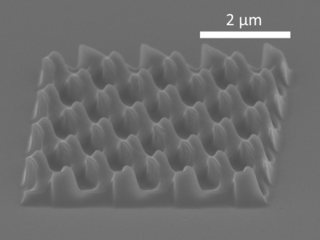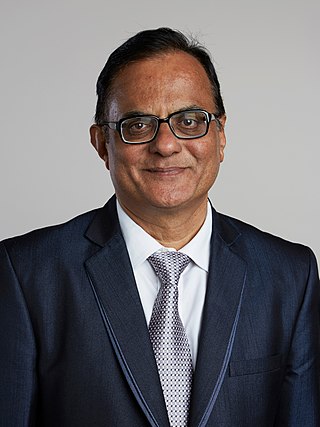Related Research Articles

A photonic crystal is an optical nanostructure in which the refractive index changes periodically. This affects the propagation of light in the same way that the structure of natural crystals gives rise to X-ray diffraction and that the atomic lattices of semiconductors affect their conductivity of electrons. Photonic crystals occur in nature in the form of structural coloration and animal reflectors, and, as artificially produced, promise to be useful in a range of applications.
Sajeev John, OC, FRSC is a Professor of Physics at the University of Toronto and Canada Research Chair holder.

The Beckman Institute for Advanced Science and Technology is a unit of the University of Illinois Urbana-Champaign dedicated to interdisciplinary research. A gift from scientist, businessman, and philanthropist Arnold O. Beckman (1900–2004) and his wife Mabel (1900–1989) led to the building of the Institute which opened in 1989. It is one of five institutions which receive support from the Arnold and Mabel Beckman Foundation on an ongoing basis. Current research at Beckman involves the areas of molecular engineering, intelligent systems, and imaging science. Researchers in these areas work across traditional academic boundaries in scientific projects that can lead to the development of real-world applications in medicine, industry, electronics, and human health across the lifespan.
SPIE is an international not-for-profit professional society for optics and photonics technology, founded in 1955. It organizes technical conferences, trade exhibitions, and continuing education programs for researchers and developers in the light-based fields of physics, including: optics, photonics, and imaging engineering. The society publishes peer-reviewed scientific journals, conference proceedings, monographs, tutorial texts, field guides, and reference volumes in print and online. SPIE is especially well-known for Photonics West, one of the laser and photonics industry's largest combined conferences and tradeshows which is held annually in San Francisco. SPIE also participates as partners in leading educational initiatives, and in 2020, for example, provided more than $5.8 million in support of optics education and outreach programs around the world.

Nanoimprint lithography (NIL) is a method of fabricating nanometer scale patterns. It is a simple nanolithography process with low cost, high throughput and high resolution. It creates patterns by mechanical deformation of imprint resist and subsequent processes. The imprint resist is typically a monomer or polymer formulation that is cured by heat or UV light during the imprinting. Adhesion between the resist and the template is controlled to allow proper release.

The Max Planck Institute for the Science of Light (MPL) performs basic research in optical metrology, optical communication, new optical materials, plasmonics and nanophotonics and optical applications in biology and medicine. It is part of the Max Planck Society and was founded on January 1, 2009 in Erlangen near Nuremberg. The institute is based on the Max Planck Research Group "Optics, Information and Photonics", which was founded in 2004 at the University of Erlangen-Nuremberg, as a precursor. The institute currently comprises four divisions.

Jonathan P. Dowling was an Irish-American researcher and professor in theoretical physics, known for his work on quantum technology, particularly for exploiting quantum entanglement for applications to quantum metrology, quantum sensing, and quantum imaging.
Daniel Thomas Gillespie was a physicist who is best known for his derivation in 1976 of the stochastic simulation algorithm (SSA), also called the Gillespie algorithm. Gillespie's broader research has produced articles on cloud physics, random variable theory, Brownian motion, Markov process theory, electrical noise, light scattering in aerosols, and quantum mechanics.

A colloidal crystal is an ordered array of colloid particles and fine grained materials analogous to a standard crystal whose repeating subunits are atoms or molecules. A natural example of this phenomenon can be found in the gem opal, where spheres of silica assume a close-packed locally periodic structure under moderate compression. Bulk properties of a colloidal crystal depend on composition, particle size, packing arrangement, and degree of regularity. Applications include photonics, materials processing, and the study of self-assembly and phase transitions.

A photonic metamaterial (PM), also known as an optical metamaterial, is a type of electromagnetic metamaterial, that interacts with light, covering terahertz (THz), infrared (IR) or visible wavelengths. The materials employ a periodic, cellular structure.
Richard W. Ziolkowski is an American electrical engineer and academician, who was the president of the IEEE Antennas and Propagation Society (2005), and a former vice president of this same society (2004). In 2006, he became an OSA Fellow. He is also an IEEE Fellow. He was born on November 22, 1952, in Warsaw, New York.

Younan Xia is a Chinese-American chemist, materials scientist, and bioengineer. He is the Brock Family Chair and Georgia Research Alliance (GRA) Eminent Scholar in Nanomedicine in the Wallace H. Coulter Department of Biomedical Engineering, with joint appointments in the School of Chemistry & Biochemistry, the School of Chemical & Biomolecular Engineering, and Parker H. Petit Institute for Bioengineering & Bioscience at the Georgia Institute of Technology.

Zhenan Bao, is the K. K. Lee Professor of Chemical Engineering at Stanford University, with courtesy appointments in Chemistry and Material Science and Engineering. She has served as the Department Chair of Chemical Engineering from 2018-2022. She is known for her work on organic field-effect transistors and organic semiconductors, for applications including flexible electronics and electronic skin.

Ajay Kumar Sood is an Indian physicist, researcher and is serving as the 4th Principal Scientific Adviser to the Government of India. He is also holder of 2 US and 5 Indian patents, known for his pioneering research findings on graphene and nanotechnology. He is a Distinguished Honorary Professor of Physics at Indian Institute of Science, Bangalore. The Government of India honoured him in 2013, with the Padma Shri, the fourth highest civilian award, for his contributions to the fields of science and technology. Sood was elected a Fellow of the Royal Society (FRS) in 2015. He has been on the Physical Sciences jury for the Infosys Prize from 2019.
Jiri Jonas is a professor emeritus of chemistry in the Center for Advanced Study at the University of Illinois at Urbana-Champaign. Jiri Jonas is considered a pioneer in the use of magnetic resonance imaging at high pressure, developing techniques to study the dynamic structure of liquids and proteins. This approach has been used in the study of the arc repressor, a DNA-binding protein containing 53 amino acid residues.

Prof. Ravindra Kumar Sinha is the Vice Chancellor of Gautam Buddha University, Greater Noida, Gautam Budh Nagar Under UP Government. He was the director of the CSIR-Central Scientific Instruments Organisation (CSIR-CSIO) Sector-30C, Chandigarh-160 030, India. He has been a Professor - Applied Physics, Dean-Academic [UG] & Chief Coordinator: TIFAC-Center of Relevance and Excellence in Fiber Optics and Optical Communication, Mission REACH Program, Technology Vision-2020, Govt. of India Delhi Technological University Bawana Road, Delhi-110042, India.
Chekesha M. Liddell Watson is an Associate Professor of Material Science and Engineering at Cornell University. She researches colloidal materials, and the relationship between micron and submicron length scales.

John E. Bowers is an American physicist, engineer, researcher and educator. He is the Fred Kavli Chair in Nanotechnology, the director of the Institute for Energy Efficiency and a distinguished professor in the Departments of Electrical and Computer Engineering and Materials at University of California, Santa Barbara. He was the deputy director of American Institute of Manufacturing of Integrated Photonics from 2015 to 2022.
Ida Pavlichenko is an Azerbaijani biomedical engineer and a Technology Development Fellow at the Harvard University Wyss Institute for Biologically Inspired Engineering. Pavlichenko is the co-founder and chief executive officer of PionEar Technologies, a medical device company that develops intelligent technologies for treating ear and hearing disorders. The tympanostomy technology she invented for treated recurrent ear infections has been nationally recognized for its innovative design which addresses many of the limitations of current ear tubes.
Evgenya Ivanovna Simakov is a Russian-American physicist whose research has involved photonic crystals, metamaterials with engineered band gaps that can be used to suppress unwanted resonances in particle accelerators. She has also worked on the design of small portable particle accelerators, and the use of nanoscale arrays of diamonds to control the shape of electron beams. She is a researcher at the Los Alamos National Laboratory.
References
- 1 2 Wiltzius, Pierre (1981). "Diss. ETH Nr. 6764 An investigation of the fibrinogen to fibrin transition by means of light scattering" (PDF). SWISS FEDERAL INSTITUTE OF TECHNOLOGY, ZURICH. Retrieved 25 October 2017.
- 1 2 Kloeppel, James E. (August 24, 2001). "New Beckman Institute director named". Illinois News Bureau. Retrieved 25 October 2017.
- 1 2 "Pierre Wiltzius". UC Santa Barbara. Retrieved April 26, 2017.
- 1 2 3 Polman, Albert; Wiltzius, Pierre, eds. (August 2001). "Materials Science Aspects of Photonic Crystals" (PDF). MRS Bulletin: 608–612. Retrieved 25 October 2017.
- ↑ Committee on Facilitating Interdisciplinary Research, Committee on Science, Engineering, and Public Policy, National Academy of Sciences, National Academy of Engineering, and Institute of Medicine (2005). Facilitating interdisciplinary research. Washington: National Academies Press. pp. 242–243. ISBN 978-0-309-09435-1 . Retrieved 25 October 2017.
{{cite book}}:|author=has generic name (help)CS1 maint: multiple names: authors list (link) - 1 2 3 4 Yang, Henry T. (June 11, 2008). "Memos to Campus Appointment of Dr. Pierre Wiltzius as Our Next Dean for the Division of Mathematical, Life, and Physical Sciences". Office of the Chancellor, University of California, Santa Barbara.
- ↑ "History of the Beckman Institute". Beckman Institute. Retrieved 25 October 2017.
- ↑ "Wiltzius Named Dean of Mathematical, Life, and Physical Sciences". 93106. Vol. 19, no. 1. July 14, 2008. Retrieved 25 October 2017.
- ↑ Braun, Paul V.; Wiltzius, Pierre (9 December 1999). "Microporous materials: Electrochemically grown photonic crystals". Nature. 402 (6762): 603–604. Bibcode:1999Natur.402..603B. doi:10.1038/45137. S2CID 205035283.
- ↑ Takeda, Satoshi; Wiltzius, Pierre (November 2006). "Growth of Highly Ordered Colloidal Crystals Using Self-Assembly at Liquid−Liquid Interfaces". Chemistry of Materials. 18 (24): 5643–5645. doi:10.1021/cm0615525.
- ↑ van Blaaderen, Alfons; Ruel, Rene; Wiltzius, Pierre (23 January 1997). "Template-directed colloidal crystallization". Nature. 385 (6614): 321–324. Bibcode:1997Natur.385..321V. doi:10.1038/385321a0. S2CID 4248282.
- ↑ Miyake, Masao; Chen, Ying-Chieh; Braun, Paul V.; Wiltzius, Pierre (7 August 2009). "Fabrication of Three-Dimensional Photonic Crystals Using Multibeam Interference Lithography and Electrodeposition". Advanced Materials. 21 (29): 3012–3015. Bibcode:2009AdM....21.3012M. doi:10.1002/adma.200802085. S2CID 16974674.
- ↑ Brown, Chappell (November 30, 2000). "Electronic paper writes new chapter for displays Electronic paper writes new chapter for displays". EETimes. Retrieved 25 October 2017.
- ↑ Mann, Charles C. (March 1, 2001). "Electronic Paper Turns the Page". MIT Technology Review. Retrieved 25 October 2017.
- ↑ Kahney, Leander (October 12, 1999). "E-Paper closer to delivery". Wired. Retrieved 25 October 2017.
- 1 2 Zhenan Bao, Ananth Dodabalapur, Hendrik Schon, John Rogers, Howard Edan Katz, Andrew J. Lovinger, Christian Kloc, Beltram Batlogg, Brian Crone, Kirk W. Baldwin, Valerie J. Kuck, V. Reddy Raju, Pierre Wiltzius, Elsa Reichmanis, Edwin A. Chandross, Karl Amundson, Jay Ewing, Paul S. Drzaic, "Novel organic and polymeric semiconductors for plastic electronics", Proc. SPIE 4466, Organic Field Effect Transistors, (21 December 2001); doi: 10.1117/12.451475; https://dx.doi.org/10.1117/12.451475
- ↑ "The IEEE Newsletter". IEEE North Jersey Section. August 2001.
- ↑ "Plastic Circuit Technology". R&D 100 Conference. Retrieved 25 October 2017.
- ↑ "P Wiltzius". American Association for the Advancement of Science. Retrieved 25 October 2017.
- ↑ "APS Fellow Archive". APS Physics. Retrieved 25 October 2017.